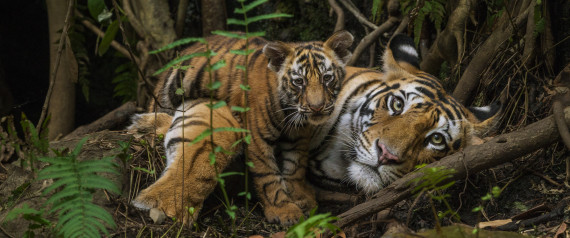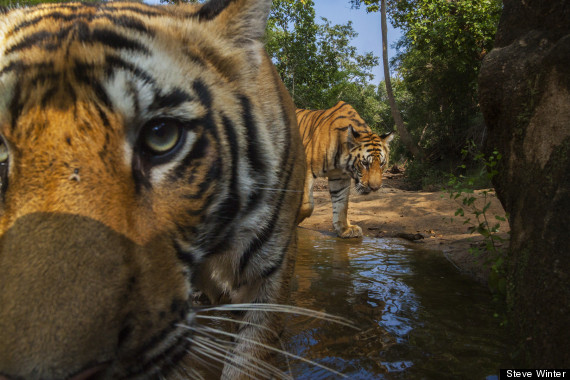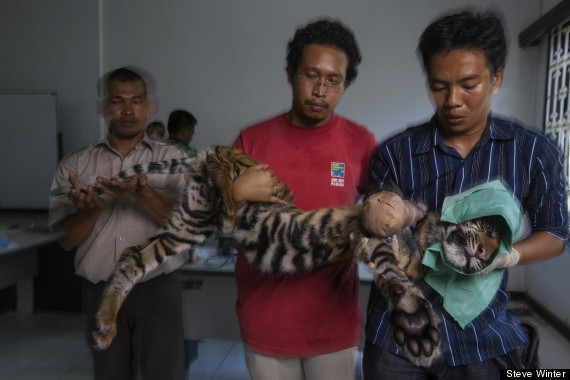Posted: 11/25/2013

Panthera tigris, the largest of the world’s cats, is the heart and soul of Asia’s jungles. It’s the dominant predator in both the valley and every ecosystem it inhabits, stealthy, walking silent and unseen, like a shadow, but possessing fearsome teeth and claws and a roar that resounds for miles. It’s no wonder tigers have long been feared and worshipped across their range. For millennia, they’ve stood as iconic symbols of power and courage, woven into culture, religion, folklore, and ritual. Neolithic cave paintings are the earliest existing depictions, images etched into rock walls across the Indian subcontinent some 8,000 years ago.
Asian cultures have deified this cat, bestowing powers beyond those of any worldly animal. In Tibet, tigers held the key to immortality. In 13th century China, tigers protected both the living and the dead by frightening away threatening spirits. In Indochina and elsewhere, many were reluctant to kill them; it was widely believed that when a tiger killed a human, the human’s soul entered and inhabited the cat’s body. The Hindu goddess Durga vanquished a monster-demon while astride her ferocious mount, a tiger.
Legend from various countries describes shamans transforming into tigers to move between worlds or people shape-shifting into werecats to harm others. Many tribes, including the Naga in Myanmar and India, only killed tigers as part of powerful rituals or on ceremonial occasions. When the Europeans arrived and trophy hunts began, those who helped or acted as guides faced harsh punishment from village elders. But as the fabric of traditional culture unraveled and guns proliferated, tiger slaughter grew common.

A cub’s curiosity is piqued by a remote-controlled camera car maneuvered by Steve Winter.
What I didn’t realize until I dug into research was that today, tigers hover closer to extinction than any of the big cats. They face a deadly cocktail of threats. With diminishing prey, widespread poaching, and conflict with humans who live too close to their ever shrinking habitat, one of the world’s most iconic species is careening toward the edge.
A century ago, more than 100,000 of these majestic cats roamed Asia’s rain forests, savannas, and mountains. They ranged across 24 nations, from Turkey eastward to Siberia, south through China and Indochina to the tip of Indonesia. They are the national animal of six nations, but have vanished from two of them, North and South Korea.
Only about 3,200 wild tigers survive, and of those, less than a third are breeding females. They’re gone from 93 percent of their historic range; that range shrank by almost half during the first decade of this century.
Tigers hang on in just 13 countries in scraps of habitat sandwiched amid an exploding human population. In 2010, they were declared extinct in Cambodia. (In contrast, at least 4,000 captive tigers are privately owned in the United States alone, living in people’s backyards, lost to the wild and often living miserable, caged lives.)
Though they’re quickly disappearing from the region, their presence here dates back millions of years. All modern cats originated in Southeast Asia. The great roaring cats, Panthera—a group that includes tigers, lions, leopards, jaguars, and snow leopards—were the first to branch off the cat family tree 10.8 million years ago.
The earliest tiger fossils are two million years old. That ancestor eventually evolved into nine subspecies, slowly adapting to Asia’s various landscapes, prey, and climate. Three of them blinked into extinction over the last 80 years. The Bali tiger died out during the 1940s; the Javan and Caspian tiger both disappeared in the 1970s. Six subspecies remain: the Bengal, Indochinese, Malayan, Sumatran, Amur (Siberian)—and the South-China, which now exists only in captivity, gone from the wild. All are endangered. In 1996, the Sumatran tiger was reclassified as critically endangered, one step from oblivion, and the Indochinese tigers that roam Myanmar and neighboring countries are approaching that same precipice.

A poacher's snare cost this six-month-old cub both its right front leg -- and its freedom. Its limb was amputated after the tiger had been trapped for three days in a snare in Aceh Province, Sumatra.
The species has always faced challenges. Genetic studies revealed that tigers were almost annihilated 73,000 years ago when a massive volcanic eruption at Lake Toba, Sumatra, wiped out scores of Asian mammals. The species rebounded from just a few individuals to repopulate Asia. Today, viable breeding populations exist in 42 known locations, or “source sites.” Tigers are in the emergency room, but they’re a resilient species. There is enough remaining habitat to support tigers, and if both the cats and their prey are given boots-on-the-ground protection, there’s hope. But only committed, targeted action and creative strategies will bring them back from the brink.
I had no inkling that this Hukawng Valley assignment would launch a decade of work documenting tigers—capturing their flaming beauty, their behaviors, the diverse environments they live in, and the prey that sustains them. My first face-to-face encounters came in September 2007, when I began work on a five-month National Geographic story on India’s Kaziranga National Park. It’s a small reserve in the Brahmaputra f loodplain that teems with life—and is home to the highest concentration of tigers anywhere in the world. By then, I’d fallen under the cat’s spell, the fire in its eyes, its power and dignity, its unchallenged rulership of the jungle.
Then, in 2009, I returned to Asia to begin a tiger story for the magazine, focusing on three subspecies in three countries: the Sumatran tiger in Indonesia, the Indochinese tiger in Thailand, and the Bengal tiger in India. My goal was to reinvigorate a passion to protect these iconic cats.
source